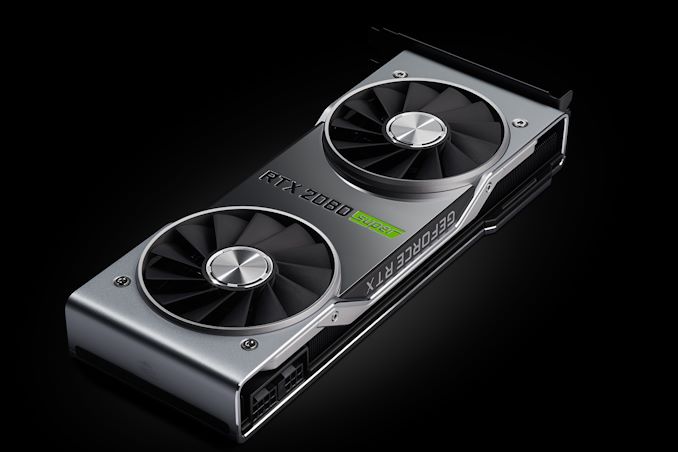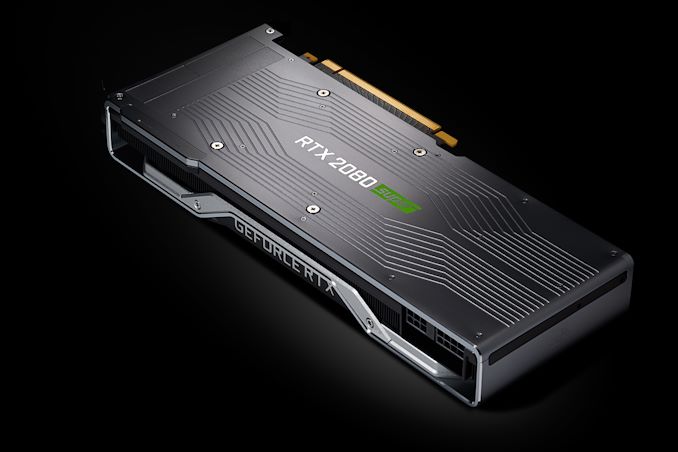The NVIDIA GeForce RTX 2080 Super Review: Memories of the Future
by Ryan Smith on July 23, 2019 9:00 AM EST- Posted in
- GPUs
- GeForce
- NVIDIA
- Turing
- GeForce RTX
Meet the GeForce RTX 2080 Super Founders Edition
Taking a closer look at the RTX 2080 Super, there aren’t too many surprises to be found. Since we’re dealing with a mid-generation kicker here, NVIDIA has opted to stick with their original RTX 2080 reference designs for the new card, rather than design wholly new boards. This has allowed them to get the new card out relatively quickly, and to be honest there’s not a whole lot NVIDIA could do here that wouldn’t be superficial. As a result, the RTX 2080 Super is more or less identical to the RTX 2080 it replaces.
| GeForce RTX 20 Series Card Compariaon | ||||
| RTX 2080 Super Founders Edition |
RTX 2080 Super (Reference Specs) |
|||
| Base Clock | 1650MHz | 1650MHz | ||
| Boost Clock | 1815MHz | 1815MHz | ||
| Memory Clock | 15.5Gbps GDDR6 | 15.5Gbps GDDR6 | ||
| VRAM | 8GB | 8GB | ||
| TDP | 250W | 250W | ||
| Length | 10.5-inches | N/A | ||
| Width | Dual Slot | N/A | ||
| Cooler Type | Open Air (2x Axial Fans) |
N/A | ||
| Price | $699 | $699 | ||
As I noted earlier, the Founders Edition cards themselves are now purely reference cards. NVIDIA isn’t doing factory overclocks this time around – the high reference clock speeds making that process a bit harder – so the RTX 2080 Super Founders Edition is very straightforward examples of what reference-clocked RTX 2080 Super cards can deliver in terms of performance. It also means that the card no longer carries a price premium, with NVIDIA selling it at $699.
Externally then, possibly the only material change is quite literally in the materials. NVIDIA has taken the 2080 reference design and given the center segment of shroud a reflective coating. This, along with the Super branding, are the only two visually distinctive changes from the RTX 2080 reference design. For better or worse, the reflective section is every bit the fingerprint magnet that you probably expect, so thankfully most people aren’t handling their video cards as much as hardware reviewers are.
In terms of cooling, this means the RTX 2080 Super gets the RTX 2080’s cooler as well. At a high level this is a dual axial open air cooler, with NVIDIA sticking to this design after first introducing it last year. The open air cooler helps NVIDIA keep their load noise levels down, though idle noise levels on all of the RTX 20 series reference cards has been mediocre, and the new Super cards are no different. The fact that this reference design isn’t a blower means that the RTX 2080 Super isn’t fully self-exhausting, relying on the computer chassis itself to help move hot air away from the card. For most builders this isn’t an issue, but if you’re building a compact system or a system with limited airflow, you’ll want to make sure your system can handle the heat from a 250W video card.
Under the hood, the RTX 2080 Super inherits the RTX 2080’s heatsink design, with a large aluminum heatsink running the full length of the card. Deeper still, the heatsink is connected to the TU104 GPU with a vapor chamber, to help move heat away from the GPU more efficiently. Overall, the amount of heat that needs to be moved has increased, thanks to the higher TDP, however as this is also the same cooler design that NVIDIA uses on the 250W RTX 2080 Ti, it's more than up to the task for a 250W RTX 2080 Super.
According to NVIDIA the PCB is the same as on the regular RTX 2080. As I need this card for further testing, I haven’t shucked it down to its PCB to take inventory of components. But as the RTX 2080 was already a "fully populated" PCB as far as VRM circuitry goes, the same will definitely be true for the RTX 2080 Super as well. I have to assume NVIDIA is just driving their VRMs a bit harder, which shouldn't be an issue given what their cooler can do. It is noteworty though that as a result, the card's maximum power target is just +12%, or 280W. So while the card has a good bit of TDP headroom at stock, there isn't much more that can be added to it. Factoring in pass-through power for the VirtualLink port, and NVIDIA is right at the limit of what they can do over the 8pin + 6pin + slot power delivery configuration.
Finally, for display I/O, the card gets the continuing NVIDIA high-end standard of 3x DisplayPort 1.4, 1x HDMI 2.0b, and 1x VirtualLink port (DP video + USB data + 30W USB power).














111 Comments
View All Comments
Korguz - Tuesday, July 23, 2019 - link
Maxiking, wow you hate amd.. but to be fair, nvidia is also guilty for the re brands as well, probably not as bad as amd.. but still bad :600 series
510 -> 605 (Fermi GF119)
GT520 -> GT610, GT620 (OEM), 705 (Fermi GF119)
GT530 -> GT620 (retail) (Fermi GF119)
GT440 (DDR3) -> GT630 (DDR3), GT730 (DDR3, 128-bit) (Fermi GF108)
GT440 (GDDR5) -> GT630 (GDDR5) (Fermi GF108)
GT545 (DDR3) -> GT640 (OEM) (Fermi GF116)
GTX560 SE (OEM) -> GT645 (Fermi GF114-400-A1)
700 series
GT630 (Kepler) -> GT740 (Kepler GK107)
GT630 (Kepler rev 2) -> GT710, GT720, GT730 (128-bit & GDDR5) (Kepler GK208)
210 -> 405 (OEM) (Tesla GT218)
GTX680 -> GTX770 (Kepler GK104)
but i am sure you will find some way to refute and ignore this fact.. but what ever man.
Spunjji - Friday, July 26, 2019 - link
If you're insisting that the RX590 is a rebrand, then congratulations, so are the Super cards - because Nvidia have done the exact same thing here (wait for yields and consistency to improve and use that to edge out a little more performance from the same silicon).You can spot the Nvidia shills because they show up yelling as though only AMD do rebrands, and as if a rebrand is somehow a form of robbery. Fact is it's been something both companies have done for decades now. Pretty sure G92 was the first product to go through three names (8800 GTS 512MB / 9800 GTX / GTS 240) and Nvidia's low-end products are even more prone to this.
ballsystemlord - Saturday, July 27, 2019 - link
FWIW: AMD's 500 series was clocked higher because the process had been improved, not because AMD wanted to make life worse for us by sandbagging on the 400 series. The 590 was just a cheap way to place something in between the 580 and Vega 56 and it was on a smaller node, so it's not *just* a rebrand. The RX 200 and 300 series were mostly rebrands, but if I'm an early adopter, how much trouble is it to check and find out that a card is just a rebrand and then not buy?jordanclock - Tuesday, July 23, 2019 - link
That is a lot of words to be wrong.These cards exist because yields got better since the architecture was launched last year. Not because of some sort of conspiracy by Nvidia to trick people into upgrading already. It's not bait-and-switch, mostly because you don't know the definition of bait-and-switch.
You don't need a card "without the ray trace crap being shoved in" because in games without RTX features, the RT cores don't do anything to harm performance in any way. The RTX 2080 performs essentially the same as a theoretical GTX 2080.
I won't address the rest of your tirade because it's clear you're just angry that Nvidia didn't come ask you personally what you wanted in a video card. While RTX hasn't been exactly a success, we should be encouraging Nvidia and AMD to find ways to improve game visuals besides higher resolution
GreenReaper - Wednesday, July 24, 2019 - link
They might need to have stocked up a sufficient number of chips of a certain quality in order to satisfy demand. It's little good announcing a card that renders another card redundant and not having enough chips to sell. You'll just get people buying neither of those cards.YB1064 - Tuesday, July 23, 2019 - link
Given the performance of AMD, it doesn't look like NVIDIA had to release anything. Their top card Radeon VII is supposed to be EOL. Looks like AMD are still far behind. Anything good on the horizon from AMD?Maxiking - Tuesday, July 23, 2019 - link
Yeah, that fabricated 4.7ghz boost on Ryzen 3950x.designgears - Tuesday, July 23, 2019 - link
They are behind at the highest end, but they're competitive in the mid-range which is where all the money is for them, so not a big deal when you look at it like that. They also power the current gen xb1/ps4 and next gen.Maxiking - Tuesday, July 23, 2019 - link
Obviously the money aren't there, the gpu division is constantly operating at a loss.Rudde - Thursday, July 25, 2019 - link
Radeon isn't operating at a loss. Apple reportedly paid a part of Vega development and they needed a gpu for their apus (i.e. all mobile parts). Vega is great at compute, earning AMD some extra revenue. Google placed a large order.Sony and Microsoft paid a part of Navi development and placed a huge order. Navi will be used in apus once again, bringing in some revenue.
Desktop gpus is not AMDs only gpu market, they need the same development for their other divisions.